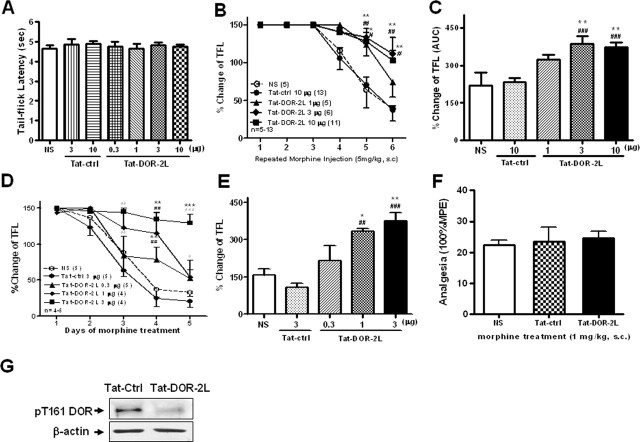Figure 7.
Administration of Tat-DOR-2L attenuates the development of morphine tolerance. A, Intrathecal injection of Tat fusion peptide had no effect on the baseline tail flick latency. B, Intrathecal pretreatment of Tat-DOR-2L for 30 min at 3 μg and at 10 μg caused profoundly slower development of morphine antinociceptive tolerance compared with Tat-ctrl or NS control groups, whereas the 1 μg dose showed a weak effect. *p < 0.05, **p < 0.01, compared with NS group; #p < 0.05, ##p < 0.01, compared with Tat-ctrl group (n = 5–13). C, Area under the curve (AUC) of B. AUC was calculated from the fourth morphine injection to the sixth morphine injection. **p < 0.01, compared with NS group; ###p < 0.001, compared with Tat-ctrl group. D, Intrathecal injections of Tat-DOR-2L (1 or 3 μg); both dosage groups developed morphine antinociceptive tolerance much more slowly than the Tat-ctrl and NS control groups, whereas the 0.3 μg dose had no effect. **p < 0.01, ***p < 0.001, compared with NS group; #p < 0.05, ##p < 0.01, ###p < 0.001, compared with the Tat-ctrl group (n = 4–5). All data were analyzed by ANOVA, followed by the Newman–Keuls multiple-comparison test. E, AUC of D. AUC was calculated from the third day to the fifth day. *p < 0.05, **p < 0.01, compared with NS group; ##p < 0.01, ###p < 0.001, compared with Tat-ctrl group. Error bars indicate SEM. F, Intrathecal pretreatment with Tat-DOR-2L (3 μg) for 30 min did not disrupt the antinociceptive effect induced by subcutaneous injection of morphine (1 mg/kg, a dose that gives 20% maximal possible effect) (n = 4–5). G, Representative Western blot analysis of DRG protein isolated from rats treated with morphine repeatedly, pretreatment with Tat-DOR-2L or Tat-ctrl, blotted with pT161 DOR antibody. Total DRG lysates were immunoblotted with actin antibody as loading controls.

